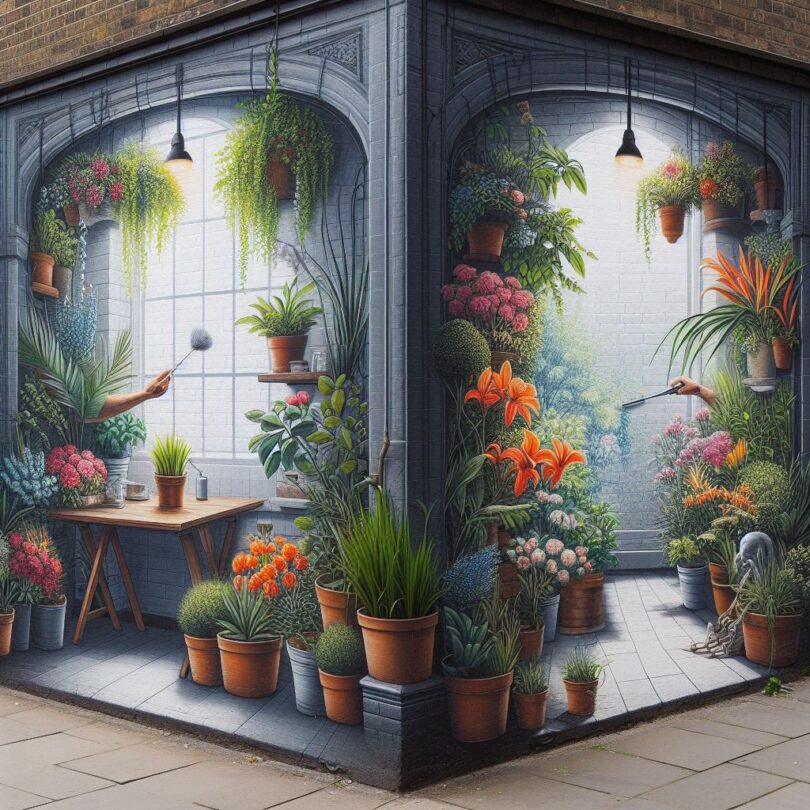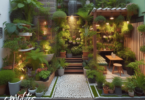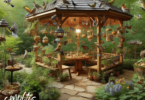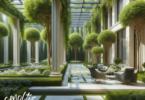Shaded areas in a garden often pose a challenge when it comes to creating an inviting and vibrant space. These dull corners can feel neglected and unappealing without the right touch. However, with the strategic use of plants, these shaded areas can be transformed into beautiful and enchanting retreats that are bursting with life.
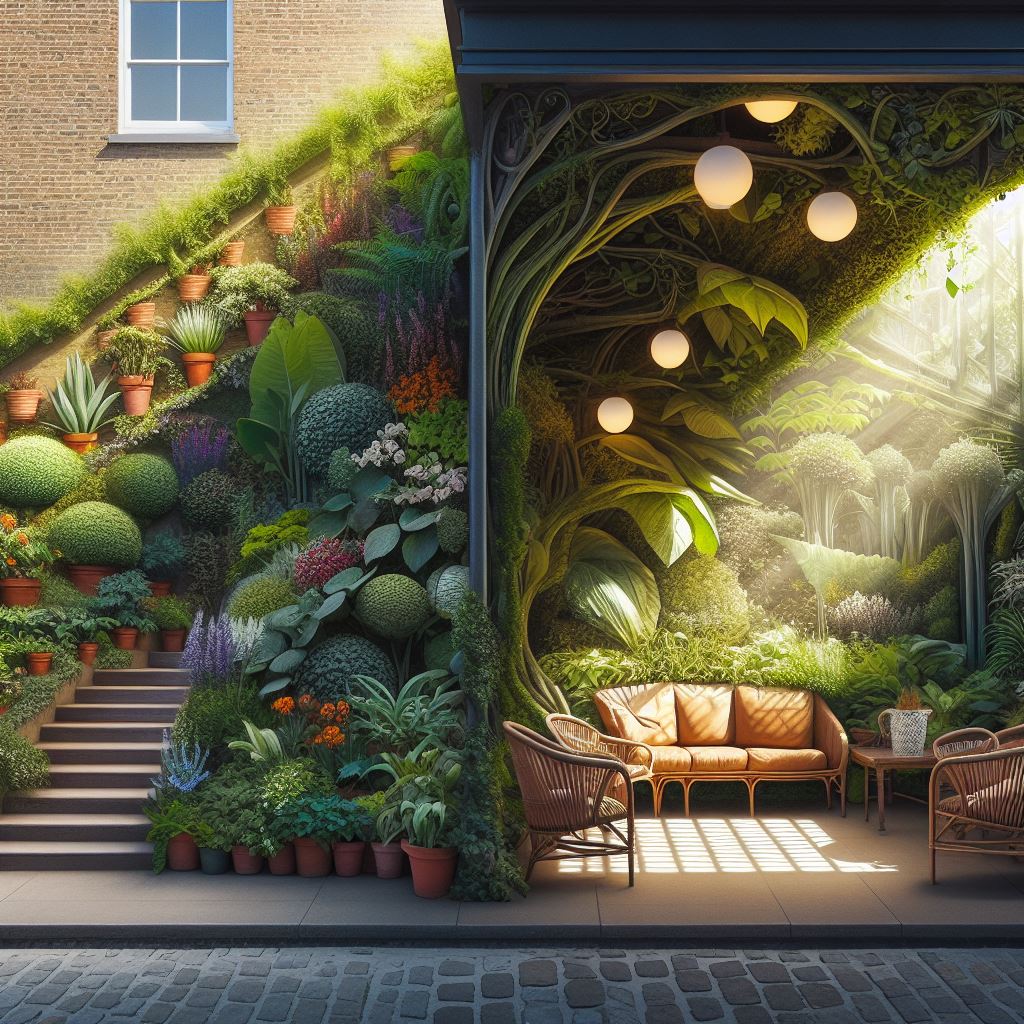
Integrating a variety of plants into shaded areas not only adds color and texture but also revitalizes the overall garden design. By carefully selecting the right plants suited for low light conditions, you can breathe new life into these neglected areas and create a captivating oasis.
In this article, we will explore the art of brightening shaded areas with plants, from understanding garden design principles to selecting the perfect foliage for your specific needs. We will uncover the secrets to designing a shade garden that thrives and discuss how additional features can enhance these spaces further.
Key Takeaways:
- Transform dull corners in your garden by incorporating plants in shaded areas.
- Understand the different types of shade and its impact on garden design.
- Select plants that thrive in low light conditions for shaded areas.
- Create visual interest in your shade garden by incorporating various plant heights, textures, and colors.
- Enhance shaded areas with additional features such as ornaments and focal points.
Understanding Shaded Areas and Garden Design
When it comes to designing a garden, understanding the concept of shaded areas is crucial. Shaded areas refer to sections of the garden that receive limited or no direct sunlight throughout the day. These areas can be caused by buildings, trees, or other structures that cast shadows over the landscape.
Creating a shade garden requires careful consideration of several factors. The type of shade plays a significant role in determining the plants that will thrive in the area. There are different types of shade, including partial shade, dappled shade, and deep shade, each with its own light levels and requirements.
To effectively design a shade garden, it is essential to evaluate the amount of shade the area receives and choose plants that can tolerate these conditions. Some plants are better suited for partial shade, while others can flourish in areas with deep shade.
Key Factors to Consider for Shade Garden Design
1. Light Levels: Assess the amount of sunlight the shaded area receives to determine the appropriate plant selection.
2. Soil Quality: Check the soil’s moisture levels and drainage capacity to ensure it can support the chosen plants.
3. Plant Compatibility: Consider the compatibility of different plants when designing the garden, ensuring they can coexist and thrive together.
When it comes to choosing the best plants for shaded areas, there is a wide variety of options to consider. Some popular choices include hostas, ferns, astilbes, and bleeding hearts. These plants are known for their ability to thrive in low light conditions and add beauty and color to shaded gardens.
In addition to selecting the best plants, incorporating different textures and heights can create visual interest in a shade garden. Mixing plants with varying leaf shapes and sizes can add depth and dimension to the landscape. Highlighting contrasting colors, such as pairing variegated foliage with darker greens, can also create a striking effect.
Overall, understanding shaded areas and their impact on garden design is crucial for transforming dull corners in a garden into vibrant, inviting spaces. By choosing the best plants for shaded areas and considering other key factors, such as light levels and soil quality, gardeners can create a beautiful and thriving shade garden.
Selecting the Perfect Plants for Shaded Areas
When it comes to shaded garden design, choosing the right plants is crucial for creating a vibrant and visually pleasing space. Whether you have a small corner or an entire shaded area, selecting plants that thrive in low light conditions is essential. In this section, we will explore a diverse range of options, including suitable shrubs, perennials, and groundcovers, to help you bring life to your shaded garden.
Shrubs for Shaded Areas
Shrubs are an excellent choice for adding structure and texture to shaded areas. These hardy plants can provide a beautiful backdrop for your garden. Some of the best shrubs for shaded areas include:
- Rhododendron: Known for their stunning blooms, rhododendrons thrive in shady conditions. With their vibrant colors and lush foliage, they can add a touch of elegance to any garden.
- Azalea: Similar to rhododendrons, azaleas also offer a wide variety of colors and sizes. These flowering shrubs brighten up shaded areas with their vibrant blooms.
- Hydrangea: Hydrangeas are known for their large and luscious flower clusters. These shade-loving shrubs can thrive in a variety of soil conditions, making them a versatile choice for shaded gardens.
Perennials for Shaded Areas
Perennials are plants that come back year after year, adding beauty and color to your garden. Here are some of the best perennials for shaded areas:
- Hosta: Hostas are known for their stunning foliage, which comes in various shades of green, blue, and even yellow. They are low-maintenance plants that do well in shady spots.
- Bleeding Heart: With their heart-shaped flowers and delicate foliage, bleeding hearts are a classic choice for shaded gardens. These perennials can add a touch of romance to your outdoor space.
- Heuchera: Also known as coral bells, heuchera offers a wide range of foliage colors, including shades of green, silver, and purple. These versatile perennials can thrive in both shade and partial sun.
Groundcovers for Shaded Areas
Groundcovers play a vital role in shaded garden design, filling in gaps and adding visual interest to the lower levels of the garden. Here are some groundcovers that are well-suited for shaded areas:
- Impatiens: Impatiens are popular for their colorful flowers and ability to thrive in shaded conditions. With their low-growing habit, they make an excellent choice for groundcover in shady areas.
- Allegheny Spurge: This evergreen groundcover features glossy foliage and small white flowers. It can create a lush carpet-like effect in shaded areas, providing a beautiful backdrop for other plants.
- Pachysandra: Pachysandra is a low-maintenance groundcover that spreads quickly in shaded areas. Its glossy green leaves add life and texture to the landscape, making it a popular choice for shaded gardens.
By carefully selecting the right plants for shaded areas, you can create a lush and inviting garden. Whether you choose shrubs, perennials, or groundcovers, ensure that they are well-suited to the low light conditions of your shaded garden. Combine plants with different heights, textures, and colors to create a visually appealing and harmonious space.
| Plant | Type | Light Requirement | Benefits |
|---|---|---|---|
| Rhododendron | Shrub | Partial shade to full shade | Stunning blooms, adds structure |
| Azalea | Shrub | Partial shade to full shade | Colorful blooms, variety of sizes |
| Hydrangea | Shrub | Partial shade to full shade | Large flower clusters, versatile |
| Hosta | Perennial | Partial shade to full shade | Stunning foliage, low maintenance |
| Bleeding Heart | Perennial | Partial shade to full shade | Unique heart-shaped flowers |
| Heuchera | Perennial | Partial shade to full shade | Various foliage colors |
| Impatiens | Groundcover | Partial shade to full shade | Colorful flowers, low-growing habit |
| Allegheny Spurge | Groundcover | Partial shade to full shade | Glossy foliage, lush carpet-like effect |
| Pachysandra | Groundcover | Partial shade to full shade | Low-maintenance, spreads quickly |
Designing a Shade Garden
When it comes to gardening in the shade, creating a well-designed shade garden is essential for maximizing the beauty and functionality of these areas. By incorporating various design elements, you can create a visually compelling space that thrives in low light conditions.
One of the key techniques for creating visual interest in a shade garden is to play with different heights, textures, and colors of plants. By combining plants with varying heights, from low groundcovers to tall shrubs, you can add depth and dimension to the garden. Consider incorporating plants with interesting foliage textures, such as ferns or hostas, to add further visual appeal.
Additionally, the use of contrasting colors can create a stunning effect in a shade garden. Select plants with vibrant foliage, such as heucheras or coleus, to provide pops of color and create focal points within the shaded area. You can also use flowers that thrive in low light conditions, such as impatiens or begonias, to add splashes of color throughout the garden.
Soil preparation is another crucial aspect of designing a shade garden. Many shade-loving plants require well-draining soil with sufficient organic matter. Prior to planting, it is recommended to amend the soil with compost or well-rotted manure to improve drainage and increase nutrient content. Regular soil maintenance, including mulching and fertilizing, will help ensure the health and longevity of your shade garden.
Maintaining a Shade Garden
Proper maintenance is vital for the success of a shade garden. Regular watering is essential, as shaded areas tend to have higher moisture levels. However, it’s crucial to avoid overwatering, as this can lead to root rot. Watering deeply and infrequently is recommended to encourage deep root growth.
Regularly inspecting the garden for pests and diseases is also important. Shade gardens can sometimes be more prone to issues such as fungal infections or slugs. Promptly addressing any pest or disease problems will help maintain the health and vigor of your plants.
“By incorporating various design elements, you can create a visually compelling space that thrives in low light conditions.”
By paying attention to design principles and proper maintenance, you can create a shade garden that flourishes with lush greenery and captivating colors. Investing time and effort into designing and caring for your shade garden will result in a beautiful outdoor space that you can enjoy year-round.
Enhancing Shaded Areas with Additional Features
In addition to incorporating plants, there are various other features that can enhance shaded areas and elevate the overall design of your garden. These additional elements can create focal points, add character, and make the shaded areas truly stand out.
Shade-Loving Ornaments
One way to enhance shaded areas is by using shade-loving ornaments. Sculptures, birdbaths, and benches can add visual interest and provide a peaceful atmosphere. These elements can serve as focal points within the shaded corners, drawing attention and creating a sense of harmony.
“A well-placed sculpture can transform a shaded corner into a captivating space, adding artistic flair and intrigue,” says renowned garden designer Alice Green.
Consider selecting ornaments that complement the existing plant selection and harmonize with the overall garden design. Opt for materials that blend well with the natural surroundings, such as stone, metal, or wood.
Lighting
Adding lighting to shaded areas can create a magical ambiance, especially in the evenings. Soft, warm lights strategically placed among the plants and ornaments can highlight their beauty and provide an enchanting glow.
LED string lights or solar-powered lanterns are popular choices for illuminating shaded areas without requiring complex wiring. Place them along paths, around seating areas, or around trees to create a mesmerizing effect.
Water Features
Integrating a water feature into a shaded garden can bring a calming and serene atmosphere. Fountains, small ponds, or waterfalls can provide a soothing sound and create a focal point that contrasts beautifully with the surrounding plant life.
When selecting a water feature, consider its size and scale to ensure it complements the shaded area. Opt for options that use a recirculating pump system, as these are generally low-maintenance and don’t require a constant water supply.
Seating Areas
To fully enjoy the shaded areas, it’s crucial to provide seating areas where one can relax and appreciate the garden’s beauty. Benches, hammocks, or cozy outdoor armchairs can be strategically placed under trees or alongside lush plantings, encouraging people to sit and unwind.
Choose seating options that harmonize with the garden’s aesthetics and offer comfort. Weather-resistant materials like teak or wrought iron are popular choices for outdoor furniture due to their durability and timeless appeal.
By incorporating shade-loving ornaments, lighting, water features, and seating areas, you can transform shaded corners into inviting retreats that captivate the senses and provide a tranquil oasis within your garden.
Comparing Different Ornamental Features for Shaded Gardens
| Feature | Benefits | Considerations |
|---|---|---|
| Sculptures | Enhances artistic appeal | Choose pieces that complement the surrounding plants |
| Birdbaths | Attracts birds and adds visual interest | Regular maintenance to keep water clean and fresh |
| Benches | Provides seating and relaxation | Ensure weather-resistant materials for durability |
| Lighting | Creates a magical atmosphere | Choose solar-powered or LED lights for energy efficiency |
| Water Features | Brings a soothing and serene element | Consider maintenance needs and the size of the shaded area |
| Seating Areas | Provides a comfortable space for relaxation | Choose materials that can withstand outdoor conditions |
Conclusion
The transformation of shaded areas with plants is a creative way to breathe life into dull corners and create visually captivating gardens. By understanding the principles of shaded garden design and selecting the best plants for shaded areas, gardening enthusiasts can turn seemingly challenging spaces into thriving, colorful havens.
Choosing shade-loving plants, such as hostas, ferns, and celandine poppies, is essential for successful gardening in the shade. These plants not only tolerate low light conditions but also add texture, form, and vibrancy to shaded areas. Additionally, incorporating various design elements, such as varying plant heights, contrasting leaf shapes, and complementary colors, can further enhance the overall appeal of a shade garden.
Creating a shade garden is not limited to plant selection alone. Proper soil preparation, regular maintenance, and strategic placement of additional features, such as decorative ornaments and seating areas, can greatly elevate the ambiance of shaded spaces. These elements contribute to an inviting atmosphere that encourages relaxation and appreciation of the natural beauty surrounding it.
With a thoughtful approach to shaded garden design, anyone can enjoy the benefits of a lush and thriving garden, even in the shadiest areas. So, whether you have a small, shaded backyard or a vast landscape dotted with mature trees, embrace the challenge and let the magic of plants transform your outdoor haven into a captivating shade garden.
FAQ
What are some benefits of incorporating plants in shaded areas?
Plants in shaded areas can provide visual interest and enhance the overall aesthetics of a garden. They can also help reduce heat and provide a cooling effect. Additionally, shade-loving plants can thrive in low light conditions, making it easier to maintain a lush and green garden in areas with limited sunlight.
What factors should I consider when designing a shade garden?
When designing a shade garden, it is important to consider the specific type of shade in your garden, such as full shade, partial shade, or dappled shade. You should also consider the moisture levels and soil conditions in the shaded area. Additionally, consider the height, texture, and color of the plants to create visual interest and balance in the garden.
Which plants are best suited for shaded areas?
There are several plants that are well-suited for shaded areas. Some popular options include ferns, hostas, astilbes, heucheras, and bleeding hearts. These plants thrive in low light conditions and can add beauty and variety to shaded gardens. It is important to select plants that are adapted to the specific shade levels and soil conditions in your garden.
How can I create visual interest in a shade garden?
To create visual interest in a shade garden, you can incorporate plants with varying heights, textures, and colors. Use taller plants as a backdrop and place smaller plants with different leaf shapes and textures in the foreground. Consider adding pops of color through flowering plants and utilize different shades of green to create depth. Incorporating elements like rocks, pathways, and garden ornaments can also add architectural interest to the garden.
What additional features can enhance shaded areas?
In addition to plants, there are several features that can enhance shaded areas. Consider adding shade-loving ornaments such as garden sculptures, birdbaths, or benches to create focal points and add visual interest. Adding lighting elements, such as solar-powered lights or string lights, can also extend the enjoyment of the shade garden into the evening hours.

